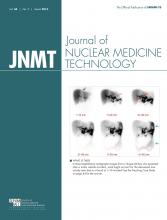Norman E. Bolus, MSPH, MPH, CNMT, FSNMMI-TS
The Merriam-Webster Dictionary defines advocacy as “the act or process of supporting a cause or proposal.” By this definition, one could advocate for anything one supports. Why is that important in our profession? I think the answer is best summarized in two recent articles in our Uptake newsletter (http://www.snmmi.org/NewsPublications/). If you have not read the article by Sara Johnson (current SNMMI-TS president-elect) in the November–December 2015 issue of Uptake on the intrusions into our scope of practice, I suggest you take the time to do so. Her main concern is that we are losing the ability to do our job. To me, this is a call to action for our profession, and we should advocate to retain our rights under our scope of practice to do what we are trained and educated to do.
However, although we should take action as individuals, the important point I would like to make is that the SNMMI does this on our behalf as members by consistently taking the lead in advocating for our profession. Many people may not realize how important this advocacy is to our field and profession and how great a benefit of SNMMI membership it is. It is certainly not something we “see” coming directly back to us as a benefit, such as discounts on books, but it may be the most important thing the SNMMI does for our profession as a whole. For example, in the January–February 2016 Uptake, the “Advocacy Corner” article mentions some successes of the SNMMI in advocating for us—obtaining research funding from the Department of Energy and securing passage of the American Medical Isotopes Production Act and appropriate reimbursements for nuclear medicine. By becoming a member, we are automatically supporting these efforts and, thereby, our field and profession. And that is important in itself. The more members we have, the bigger our advocacy efforts can be, and that synergy will help our profession overall. So although I like to endorse many benefits in our profession, one of the most important is membership and belonging to the SNMMI. Just by being a member, you are giving back to our profession and helping it. For this very reason, I urge you to encourage others who are not members to join the SNMMI.
There are other benefits to being a member of the SNMMI as well. If you go to the member benefits page on the SNMMI website (http://www.snmmi.org/Membership/), you will find information on publications, continuing education (CE), career assistance, discounts, special-interest groups, resources, and advocacy. I would argue that the most important benefit is advocacy, for the reasons stated above. The problem is that advocacy is the benefit having the least direct effect on an individual although I believe it to have the greatest effect, over the long term, on our profession.“Advocacy groups and voters are not wrong to push candidates to declare their position clearly on policy issues. That is good citizenship. Hard questions should be asked of every candidate, every politician. And those public servants should be prepared to answer, but in their own words.”
—Mark McKinnon
The June issue of JNMT will have two original CE articles, and in the current issue we are reprinting a two-part CE article on gastrointestinal motility that appeared last year in JNM. These articles contain useful information on some types of scans that are not necessarily routine in nuclear medicine, such as esophageal transit, gastric emptying, small-bowel transit, and colon transit. As in previous JNM reprints, if you have already received CE credit from these articles, you cannot receive credit twice. In addition to these articles, we have an editorial on the Nuclear Medicine Advanced Associate profession, as well as imaging articles on a range of topics: PET/CT prostate and bone metastases, the minimal required activity for 18F-FDG PET/CT imaging, a cardiac phantom, and acceptance testing of a PET scanner. There are also 5 teaching case reports on interesting topics: scintigraphic localization of a bile leak, incidental liver findings on myocardial perfusion SPECT, 11C-acetate PET/CT detection of prostate cancer metastases, SPECT/CT evaluation of mandibular condylar hyperplasia, and diagnosis of a dual malignancy using 18F-FDG. Also included is a review of a relatively new SNMMI book, Basic Science of Nuclear Medicine: The Bare Bone Essentials.
In our Facebook discussion for this issue (www.snmmi.org/facebook), I simply ask the question, “What issues do you want the SNMMI to advocate for our profession?”








